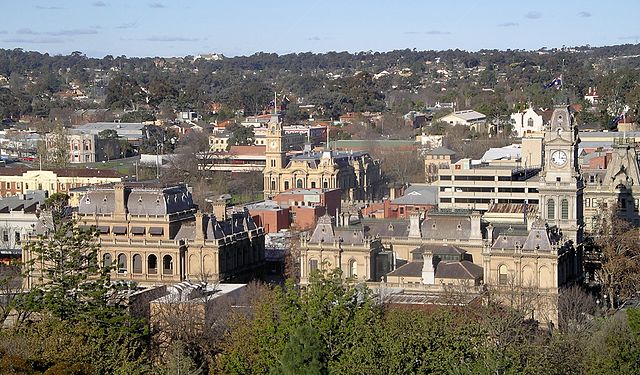Top Qs
Timeline
Chat
Perspective
Division of Bendigo
Australian federal electoral division From Wikipedia, the free encyclopedia
Remove ads
The Division of Bendigo is an Australian electoral division in the state of Victoria. The division was proclaimed in 1900, and was one of the original 65 divisions to be contested at the first federal election. It is named for the city of Bendigo.
The division is situated on the northern foothills of the Great Dividing Range in North Central Victoria. It covers an area of approximately 5,496 square kilometres (2,122 sq mi) and provides the southern gateway to the Murray–Darling basin. In addition to the city of Bendigo, other large population centres in the division include Castlemaine, Heathcote and Kyneton.[1]
The current Member for the Division of Bendigo, since the 2013 federal election, is Lisa Chesters, a member of the Australian Labor Party.
Remove ads
Geography
Summarize
Perspective
Since 1984, federal electoral division boundaries in Australia have been determined at redistributions by a redistribution committee appointed by the Australian Electoral Commission. Redistributions occur for the boundaries of divisions in a particular state, and they occur every seven years, or sooner if a state's representation entitlement changes or when divisions of a state are malapportioned.[2]
In 1913, it gained Maldon and Castlemaine from the abolished Division of Laanecoorie, but lost Heathcote.[3] In 1937, with the abolition of the Division of Echuca, the division expanded north to the state border with New South Wales to include Echuca and Rochester.[4] 12 years later in 1949, this was reversed with the creation of the Division of Murray around those areas.[5][6]
In 1955, the division expanded east to include Seymour. In 1968, it expanded towards the south-east into other towns along the Calder Highway, such as Gisborne and Lancefield, and other towns along the Hume Highway, such as Kilmore and Wandong. The expansion replaced the northern part of Division of Lalor.[5][7] Kilmore and Lancefield were lost to Division of Burke in 1977.[8] In 1984, the division was significantly shifted west, losing all areas along the Hume Highway (Seymour, Kilmore and Wandong) to the new Division of McEwen.[5][9]
In the 2024 redistribution, it was proposed in May 2024 that the division be expanded southwards towards the Shire of Hepburn and replacing parts of Division of Ballarat.[10] However, in the final redistribution in October 2024, the division was instead expanded northwards into Shire of Campaspe and included the town of Rochester, which was previously in Division of Nicholls. A proposed expansion to the east into the towns of Toolborac and Pyalong also went ahead.[11][12]
Remove ads
History
Summarize
Perspective

In the early years of federation the seat consisted of little more than Bendigo itself, but on later boundaries the seat has included towns such as Echuca, Castlemaine, Maryborough and Seymour.
Bendigo has been a marginal seat, changing hands regularly between the Labor Party and the conservative parties; typically mirroring voting patterns in state elections.[13] However, it has remained a Labor seat since the 1998 federal election.
Unlike most marginal seats, Bendigo is not a barometer for winning government. Since 1949, all but one of its members has spent at least one term in opposition. Indeed, during two elections that saw a change of government, it elected an opposition MP.
Its most notable members include its first representative, Sir John Quick, who was a leading federalist, and Prime Minister Billy Hughes who, although from Sydney, represented Bendigo for two terms at a time when the federal Parliament met in Melbourne, and who moved to the seat after leaving the Labor Party over conscription, holding the seat as the leader of the Nationalist Party.
John Brumby, who held the seat from 1983 to 1990, would subsequently be elected to the Victorian Legislative Council in 1993. He then transferred to the Victorian Legislative Assembly seat of Broadmeadows a few months later, after being elected Victorian Opposition Leader, a position he would hold until 1999. After serving as a senior state minister under Steve Bracks, Brumby went on to become Premier of Victoria from 2007 to 2010.
Brumby was defeated in Bendigo at the 1990 election by a former state Legislative Councillor, Bruce Reid, who retained the seat narrowly in 1993 and 1996, before retiring at the 1998 election, when a 4.3% swing delivered the seat to Labor's Steve Gibbons. Reid has a minor claim to fame through being the third candidate in the contest for Liberal leadership between John Hewson and John Howard after the party's 1993 election defeat. Reid attracted one vote, presumably his own.[13]
Remove ads
Members
Remove ads
Election results
Remove ads
References
External links
Wikiwand - on
Seamless Wikipedia browsing. On steroids.
Remove ads

















